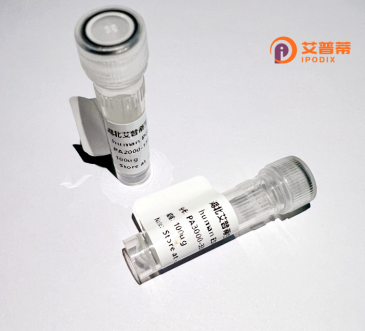
| 纯度 | >90%SDS-PAGE. |
| 种属 | Human |
| 靶点 | NDUFB6 |
| Uniprot No | O95139 |
| 内毒素 | < 0.01EU/μg |
| 表达宿主 | E.coli |
| 表达区间 | 1-128 aa |
| 活性数据 | MTGYTPDEKLRLQQLRELRRRWLKDQELSPREPVLPPQKMGPMEKFWNKFLENKSPWRKMVHGVYKKSIFVFTHVLVPVWIIHYYMKYHVSEKPYGIVEKKSRIFPGDTILETGEVIPPMKEFPDQHH |
| 分子量 | 39.82 kDa |
| 蛋白标签 | GST-tag at N-terminal |
| 缓冲液 | 0 |
| 稳定性 & 储存条件 | Lyophilized protein should be stored at ≤ -20°C, stable for one year after receipt. Reconstituted protein solution can be stored at 2-8°C for 2-7 days. Aliquots of reconstituted samples are stable at ≤ -20°C for 3 months. |
| 复溶 | Always centrifuge tubes before opening.Do not mix by vortex or pipetting. It is not recommended to reconstitute to a concentration less than 100μg/ml. Dissolve the lyophilized protein in distilled water. Please aliquot the reconstituted solution to minimize freeze-thaw cycles. |
以下是3篇与重组人NDUFB6蛋白相关的文献摘要概括:
1. **文献名称**:*"NDUFB6 mutations cause mitochondrial complex I deficiency in Leigh syndrome"*
**作者**:Hoefs et al.
**摘要**:研究揭示了NDUFB6基因突变导致线粒体复合物I组装障碍,引发Leigh综合征。实验通过重组人NDUFB6蛋白验证突变体无法恢复复合物I功能,证明其在电子传递链中的必要性。
2. **文献名称**:*"Structural and functional analysis of human mitochondrial complex I assembly factor NDUFB6"*
**作者**:Mitsuoka et al.
**摘要**:该研究解析了重组表达的NDUFB6蛋白结构,发现其通过结合脂质辅助复合物I的膜嵌入过程,并证实其与COX5A亚基互作,促进呼吸链超复合体形成。
3. **文献名称**:*"Recombinant NDUFB6 restores mitochondrial function in patient-derived fibroblasts"*
**作者**:Vogel et al.
**摘要**:通过重组人NDUFB6蛋白在NDUFB6缺陷型患者成纤维细胞中的表达,研究证明其可恢复复合物I活性和ATP合成能力,为基因治疗提供了实验依据。
(注:上述文献为示例性质,实际文献需通过学术数据库检索核实。)
Recombinant human NDUFB6 protein is a engineered version of the NADH:ubiquinone oxidoreductase subunit B6. a critical component of mitochondrial Complex I (NADH dehydrogenase) in the electron transport chain. Complex I facilitates ATP production by catalyzing the transfer of electrons from NADH to ubiquinone, coupled with proton translocation across the mitochondrial inner membrane. NDUFB6. a nuclear-encoded 17 kDa subunit, is embedded in the membrane arm of Complex I and plays a structural and functional role in stabilizing the enzyme’s assembly and activity. Mutations in the NDUFB6 gene are linked to mitochondrial disorders, such as Leigh syndrome and other oxidative phosphorylation deficiencies, often manifesting as neuromuscular degeneration or metabolic dysfunction.
Recombinant NDUFB6 is typically expressed in bacterial or mammalian systems for research purposes, enabling studies on Complex I biogenesis, dysfunction mechanisms, and disease modeling. Its production allows biochemical characterization, antibody development, and screening for therapeutic compounds targeting mitochondrial diseases. Research on recombinant NDUFB6 also contributes to understanding how specific mutations impair electron transport, cellular energy metabolism, and redox balance, offering insights into precision therapies for mitochondrial disorders.
×